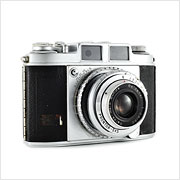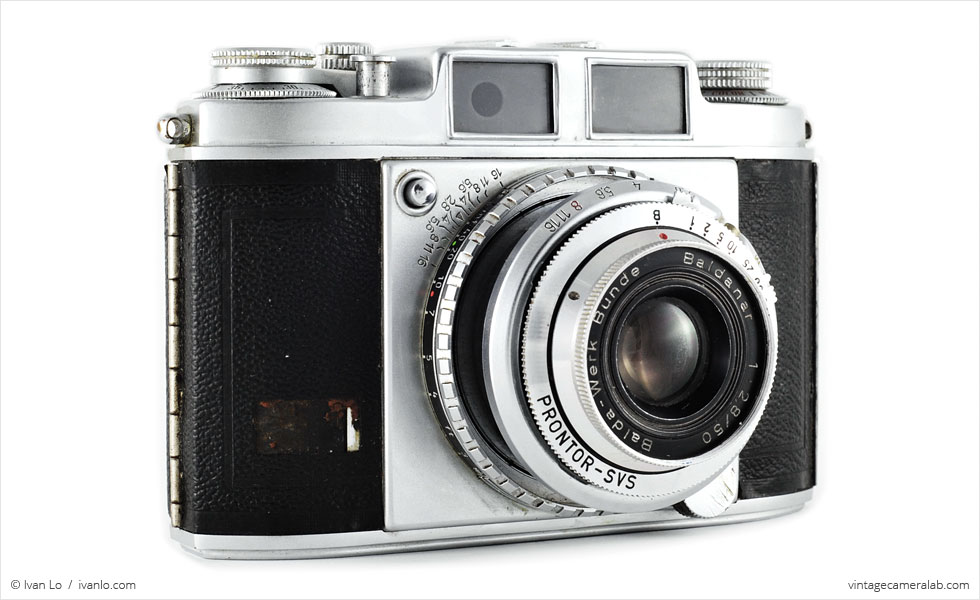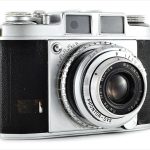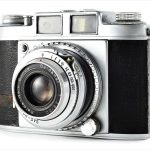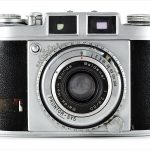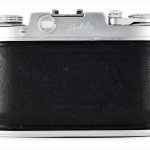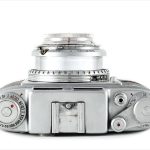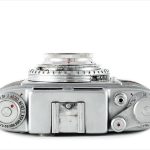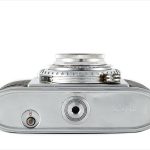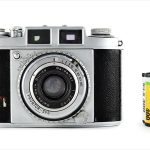Balda Super Baldina Specifications
| Manufacturer: | Balda Kamera-Werk |
| Origin: | West Germany |
| (modern day Germany) | |
| Made in: | West Germany |
| (modern day Germany) | |
| Introduced: | 1954 |
| Type: | Rangefinder |
| Format: | 135 Film |
| Dimensions: | 13 x 8.6 x 5.5 cm (closed) |
| 13 x 8.6 x 7.4 cm (open) |
Balda Super Baldina Overview
The Balda Super Baldina name has actually been used on two different cameras, one is a folding rangefinder introduced by Balda Kamera-Werk in 1938 and the other is the one pictured above: a fixed-lens rangefinder from the mid 1950s. Both incarnations of the Super Baldina have been released alongside view-finder only “normal” Baldinas.
Perhaps the most notable feature on the Super Baldina is its telescoping lens that automatically pops out with a push of that tiny silver button in the corner of the lens plate. The Super Baldina was available with a wide variety of fixed lenses including several excellent designs by legendary German lensmakers such as Schneider Kreuznach, Carl Zeiss, and Rodenstock. The one I’ve got, however, is equipped with an in-house 50mm f/2.8 Baldanar lens. The Super Baldina came with two choices of shutter: a Synchro-Compur or, like this one, a Prontor-SVS shutter that can synchronize with both electronic flash units (“X” mode) as well as flash bulbs (“M”) and an integrated self-timer (“V”).
Like most expandable cameras, the Balda’s lens must first be extended before the shutter can be fired. Once ready, the shutter speed can be selected by rotating the wheel immediately surrounding the front element and the aperture can be set by moving the metal tab just behind it. On the other side of the flash sync socket from the aperture selection tab is the shutter mode selector (X, V, M) mentioned at the end of the previous paragraph. Focusing the lens is done by using the metal nub at the base of the lens barrel to rotate the focus ring. Once everything is set, the focus then shifts to the camera’s top plate that features—starting from the user’s left—the film type indicator surrounding the rewind knob, cold shoe, shutter button, and film advance lever surrounded with the frame counter at its base.
I happened upon this Super Baldina on eBay and got it for cheap because the seller had labeled it poorly and there were no other bidders. The reason behind the confusion was that the rectangular badge that says “Super Baldina” was missing from the front. The seller erroneously labeled the camera as a “Baldanar” (the name of the lens) and left it at that. Besides the missing badge and a few small scuffs here and there, the Balda is in great shape. I’m fond of non-folding expandable cameras like the M.I.O.M. Photax III, and the Agfa PD16 Clipper so buying the Super Baldina was an easy choice to make.
Find your very own Balda Super Baldina on eBay.
McKeown, James M. and Joan C. McKeown’s Price Guide to Antique and Classic Cameras, 2001-2002. (Grantsburg, WI, USA: Centennial Photo Service, 2001), p 79, 83.
